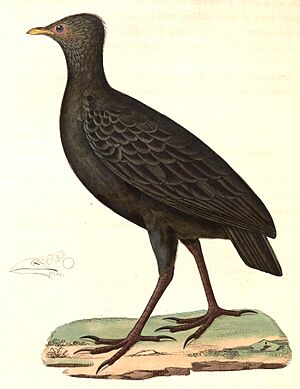Dusky megapode facts for kids
Quick facts for kids Dusky megapode |
|
|---|---|
 |
|
| Conservation status | |
| Scientific classification | |
| Genus: |
Megapodius
|
| Species: |
freycinet
|
| Subspecies | |
The dusky megapode (scientific name: Megapodius freycinet) is a fascinating bird. It's also called the dusky scrubfowl or common megapode. This medium-sized bird is about 41 cm (16 inches) long. It's known for its unique way of laying eggs.
Contents
Meet the Dusky Megapode
The dusky megapode is a special type of bird. It belongs to a group called megapodes. These birds are famous for building huge nests on the ground. They use natural heat to hatch their eggs.
What Does It Look Like?
The dusky megapode is mostly blackish in color. It has a short, pointed crest on its head. Its face has bare red skin, which makes it stand out. This bird has dark legs and brown eyes. Its beak is dark brown and yellow. Both male and female dusky megapodes look very similar.
Where Does It Live?
This bird lives on land, mostly in forests and swamps. You can find it in places like mangrove forests. Its home is in the Maluku Islands and Raja Ampat Islands. Both of these island groups are part of Indonesia.
How Does It Lay Eggs?
Unlike most birds, the dusky megapode does not sit on its eggs to keep them warm. Instead, it builds a giant mound. This mound is like a natural incubator. It's made from earth mixed with leaves, sand, gravel, and sticks. These mounds can be very large. Some can be as wide as 11 meters (36 feet) across. They can also stand nearly 5 meters (16 feet) tall! The heat from the rotting plants and the sun helps the eggs hatch.
Its Name and Status
The scientific name freycinet honors a French explorer. His name was Louis Claude Desaulses de Freycinet.
Scientists often study how different species are related. Sometimes, they disagree on how to classify certain birds. For example, some scientists used to think many megapodes were just types of the dusky megapode. But now, most experts agree they are separate species.
The dusky megapode is quite common in its natural habitat. Because of this, it is listed as "least concern" by the IUCN Red List. This means it is not currently in danger of disappearing.


